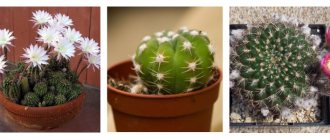Cacti grow in desert and tropical areas of Central America. Despite its drought tolerance, the plant needs some moisture. Watering cacti is especially important during the period of growth and flowering. The owner must know how to properly perform succulent care procedures at different times of the year and periods of the life cycle.
Features and rules for watering cactus
Regardless of the purpose for which you bought a cactus - growing a large number, decorating a windowsill with a couple of flowerpots, or as a gift to a loved one - you need to remember the rules of care and watering. It is a competent strategy and systematic approach that will ensure active growth, flowering and the appearance of new shoots for further replanting.
Cacti on the windowsill
It is necessary to be especially careful when watering succulents of flowering varieties, since a lack or excess of moisture can negatively affect the timely appearance of a healthy bud.
When choosing succulents as a home plant, you should not take them lightly and turn a blind eye to the rules of watering. Using the wrong water, excess fertilizer or incorrect watering techniques can cause the plant to die in a short time.
Methods
Which watering option is better - from above or into a tray - is a matter of ongoing debate among gardeners. The thing is that the bulk of the roots that absorb water are located in the very bottom of the pot. Regardless of this, each method has its positive and negative sides.
Above
Fluffy cactus: what is it called and care options
This method is more familiar, plus you can see how much water is added, although, on the other hand, many nutritional components are washed out from the upper layers of the soil.
Note! In order not to wet the cactus, it is important to add water along the edge of the flowerpot, for example, do this with a juice straw or dropper.
Through the pallet
This type is convenient, according to many gardeners, because nutritional components are not washed out of the soil, as often happens when watering from above, but with this method it can be difficult to understand how much moisture the plant needs. This option is suitable for more experienced gardeners who have been keeping cacti for a long time.
And, as many cactus owners say, there is no fundamental difference between watering into a tray or from above; it is rather a matter of experience and habit. Therefore, everyone chooses for themselves what is convenient for them.
How often to water
The frequency of watering a home cactus directly depends on many factors. The most important of them are described below.
Plant type
Astrophytum cactus: options for different types and examples of care at home
The seller must tell you about this and also provide instructions for caring for a specific variety. For example, if the future pet was brought from the desert, it will not be too whimsical and water-loving. Such plants need minimal irrigation once a week or a week and a half, and even then only in the hot summer.
Important! Succulents brought from the tropics love high humidity, so they need more frequent watering in both winter and summer.
There is nothing simpler than instructions on how to water Decembrist or prickly pear - they are not afraid of water in any quantity. Mammillaria is the same unpretentious plant.
Succulent placement
If you place a plant at home on a window located on the sunny side, or next to a powerful battery, heater, computer or laptop ventilation, it will require more moisture. In cooler and less lit areas, water less often and less frequently.
Pot material
Even such a minor detail affects the frequency. Ceramic and clay pots slightly promote moisture absorption, so more frequent and intense watering will be needed. There are much fewer problems with plastic and glass dishes.
Age of cactus
If the plant is very young, it spends more nutrients from water and substrate for its development and flowering. Therefore, it needs more moisture than its older brothers.
Different types of cactus need different frequency of watering
Life cycle
When the plant begins its growing season, that is, it actively begins to grow, and the ovary appears in flowering varieties, you need to prepare for frequent watering. This is usually the period from late spring to late autumn.
Due to the relocation of a succulent to a different environment, its natural cycle may be disrupted, and the growing season begins in winter. The change in behavior must be carefully monitored so as not to leave the plant without moisture, which is vital at this time.
Substrate condition
This is a separate and very important issue when growing a healthy and strong cactus, since most of the so-called universal store-bought substrates actually contain a lot of components that are dangerous to the plant. Sometimes the quality of the soil simply leaves much to be desired: a solid mass of peat does not deliver water to the roots, and a lot of loose sand or clay, on the contrary, leads to their rotting.
Attention! Watering the cactus and its frequency also depends on the quality of the water and the additives in it. It may be necessary to observe the moisture absorption and condition of the succulent for some time to determine the optimal frequency.
How often should you moisten the soil under a cactus?
When a gardener has cacti at home, but knows only general information about them, he begins to come up with watering schedules himself. Most often, such people are divided into two categories:
- The first category includes gardeners who are opposed to frequent watering. In their opinion, the cactus is a desert inhabitant, so it is freely able to grow for a long time without water.
- The second category includes flower growers who love the golden mean. They do not over-moisten the soil, but regularly water the flower with a small amount of water.
In both cases, flower growers make a grave mistake. There are certain requirements for watering these plants that must be met.
Advice! Cacti are easy to care for for a grower who understands their basic needs.
The frequency of watering a succulent depends on its variety. Common cacti are the most common among gardeners. They need to be watered only during active growth and flowering. It is equally important to determine the amount of water. The more active growth is observed, the more moisture the plant requires.
To determine whether a cactus needs to be watered or whether it does not yet require water, one must analyze the environment. When flowers stand on window sills in a hot room near heating radiators, moisture leaves their fleshy stems faster. Under such conditions, the frequency of soil moisture increases. Inside a cool room, where the air temperature is about +10°C, the plant’s metabolism stops. The succulent does not absorb water at all, so watering is not necessary. Moisture can only rot the roots. Here the question may arise, why then keep the flower cool. This should be done during winter dormancy.
Advice! In order not to get confused with watering, it is easier to look at the time of year. From October to early March, most cacti have a dormant period. They are placed in a cool room and not watered until early spring.
There is a variety of tropical cacti that do not need cool conditions. Sometimes even ordinary succulents continue to be kept on the windowsill in a warm room in winter. Under such conditions, plants need watering, but minimal. Under each succulent, regularly pour 1 tbsp after 7 days. l. water. Most often, such cacti are grown in clay pots. They are placed inside a volumetric box, where the voids between the flower beds are filled with peat. The filler is considered moisture-intensive. When watering in winter, only peat is moistened. In spring, cacti begin to grow. However, they are also not watered immediately. Initially, the succulent is sprayed with warm water. During the shower, the dust is washed off. The plant grows lateral roots designed to absorb moisture from the soil surface.
See also: Rose in potatoes growing method
What water to water a cactus
Ideally clean water in the modern world, especially in megacities, is a legend. Most houseplants adapt over time and respond well to regular tap water. But succulents, due to the characteristics of their origin, react painfully to poor chemical composition of water. How can you improve performance and make the watering process easier?
How to water aloe: frequency and options at home
The best way is to use collected rain or melt water. But this option requires too much effort and patience, so it is not suitable for everyone. A simpler idea is to boil and cool water to reduce its hardness and pH level. This way you can avoid alkalization of the soil and the negative effect of water on the root system when watering cacti.
Note! If you don’t have any time to manipulate water, you can use regular household filters or fill a container and let it sit for 2-3 days before watering.
To improve the quality of water and fertilizing, you can use the following means:
- oxalic or nitric acid (don’t forget to let it settle and drain off the sediment);
- succinic acid (only a one percent solution is suitable);
- diluted peat;
- vinegar 9% (no more than a teaspoon per five-liter container).
Feeding cacti
Organic and mineral fertilizers for succulents are applied only in the form of aqueous solutions. These plants react poorly to all kinds of natural fertilizers, such as manure, humus, bird droppings, herbal infusions, etc. You should also be careful with powdered home remedies - ash, crushed eggshells, chalk, as they can affect the acidity of the soil.
The optimal solution would be to use special compositions of nitrogen, potassium and phosphorus - “Agricola”, “Pokon”, “Bona Forte”, etc. In them, the proportions of additives are balanced specifically for cacti, and are contained in a form accessible to this group of plants.
It is enough to feed adult succulents 2-4 times a year. It is better to do this during the warm period, from about mid-April to the end of October.
podkormka-kaktusov-1024×687.jpg
Water temperature
How to replant a cactus: options at home
Everything here is relatively simple: under no circumstances should you water succulents with cold water. It should be room temperature, and ideally a little warmer than the air temperature. Cold and excess moisture are the two main enemies of your plant; cacti get sick and die from them.
In healthy cacti, the soil is always slightly dry
Optimal watering time
What time of day to water cacti depends on weather conditions. If it is rainy and cool outside, watering should be done in the morning. If it is hot, it is advisable to water cacti in the evening. Otherwise, during morning watering, the water that gets into the substrate will immediately evaporate, without having time to reach the lower roots.
Succulents are sensitive to hypothermia. The plant will definitely die if watered at temperatures below +15 °C and high air humidity. The roots will immediately rot. Therefore, under unfavorable microclimatic conditions, it is better to skip watering and leave the cactus alone in dry soil.
Specifics of watering depending on the season
Although the life cycle of a succulent is the most important indicator, different seasons require different strategies.
in autumn
Plants usually end their growing season and are preparing for “hibernation.” The amount of moisture must be reduced and the frequency of watering reduced to a minimum - once a month will be enough.
in winter
Succulents really go into a dormant state: they need to be placed in a cool, dark place and watering reduced to a minimum. If in the fall the frequency of watering the cactus was once a month, then in winter once or twice for the entire season will be enough.
Important! Do not be alarmed if your pet shrinks slightly - this is normal behavior and is not at all a sign that something was done incorrectly.
in spring
Spring awakening is quite slow, so plants completely return to their previous state by mid-to-late April. The main sign that the plant is entering the growing season is the appearance of new needles at the top and fresh greenery.
First you only need to lightly moisten the substrate, preferably with hot water. This will help the plant wake up faster. If the weather is sunny and the plant is “active,” you need to continue to water it gradually in the morning after the soil has completely dried. Then gradually increase the frequency of watering to once every 7-10 days.
Important! In the summer, watering the cactus should be more frequent, especially if it is in the sun. But on rainy days and high humidity there is no need to water - the plant will take everything from the air.
Common mistakes in watering procedures
Excess moisture is manifested by lethargy and wrinkling of the plant. An overwatered cactus begins to rot and can only be saved by replanting.
Photo of a rotten cactus after waterlogging
If the error is noticed immediately after irrigation, then excess water is poured out of the bowl immediately, and crumpled napkins are placed under the pot to absorb the liquid. When a cactus is overwatered in the summer, this is not as critical as in the off-season, but there is no need to immediately place it under the scorching sun, since the drying process should be more gentle.
The second common mistake is watering immediately after transplanting. The cactus feels stress and must be allowed to recover from it for 7-10 days, and only then will it need moisture, as an impetus for adaptation to new growing conditions.
The third question is the temperature and structure of the water. Cold and too hard water will not bring a positive effect and will only contribute to the rapid withering of flowering or even the death of the entire plant.
And the most critical moment will be incorrect watering and conditions for growing succulents in winter. You should not only reduce the amount and frequency of moisture application, but also ensure that the pot with the thorny bush is stored in a cool room.
Compliance with the minimum requirements to ensure comfortable growing conditions will allow you to quickly create an entire home flower bed of these exotic plants.
Ways to water a cactus
Having found out the dependence of the frequency of watering a cactus on the weather, its origin, location and other factors, it is worth understanding the technical nuances of the issue.
You can't water like that
Watering from above
Do not pour water on top of the pot, capturing the stem and flower of the succulent. Water to the plant should come from the root, and the stem can only be lightly sprayed from the smallest diffuser if a lot of dust, sand or cobwebs have collected on it.
You can water the cactus from above, but the main task is to protect the stem from excess droplets. You will need a small water container with a narrow neck to allow you to control the water flow. When top-irrigating, you should try to give so much water that the entire lump of substrate in the pot is immediately saturated, and the water reaches the roots.
Important! Irrigating the plant gradually and in small portions from above is not recommended, because it is much easier to overwater the plant and create unfavorable conditions for it.
Watering tray
This option requires a little more preparation, but is more advantageous:
- Water is guaranteed not to get on the stem and will not harm the development and growth of the succulent.
- The short root system of the cactus will receive better and faster nutrition.
- Minerals from additives and substrate will be washed out much more, providing the plant with a favorable environment for development, reproduction and flowering.
Cacti in an individual tray
For watering through a tray, it is recommended to choose low plastic pots with holes at the bottom. It is better to buy a tray with high edges so that water does not spread over the table and windowsill. In addition, depending on the size, the tray can provide moisture for either one plant or a large collection of cacti. The main thing is not to forget that some succulents may need additional feeding or, conversely, less liquid, so it is better to place them separately.
When watering through a tray, it is most difficult to track how much moisture gets into each pot, so if the cacti are capricious and need a separate irrigation regime, it is better not to experiment. If it is difficult to determine how wet the soil is, it makes sense to buy a special device for measuring moisture and adjust the soil moisture plan according to its indicators.
Important! 20-30 minutes after watering, it is necessary to remove excess water from the pan to avoid excessive moisture in the roots of the succulent.
When replanting a plant, you need to moisten the soil after transferring it to another container and leave it for a while, observing the condition. Succulents experience some stress, so they may consume less liquid.
A reliable and well-functioning regime is always good: how many times should a cactus be watered per week?
When everything has already fallen into place with the methods and methods of watering a plant of this type, it also remains to find out how often the cactus needs to be watered in order to provide it with maximum growing conditions, especially if you are breeding flowering species and expect to get aesthetic pleasure from contemplating the wonderful inflorescences . To the question of whether cacti are watered in winter, there is a completely intelligible, sensible, but not specific answer. The thing is that everything will depend on the type of cactus, its growing season, as well as the growing conditions in its native country. However, one thing is for sure, most succulents and cacti do not need watering at all, except when they bloom.
Photo from the site: womanadvice.ru
- Mostly cacti enter the growing season at the end of spring, or even early summer, and the second time, at the end of summer, or at the beginning of autumn.
- If you are wondering how often to water cacti in winter, then first decide on its growing season, and only then make a decision. During flowering, the earthen ball must be constantly moistened, otherwise the plant may simply not cope with such a load.
- You need to understand that the growth period of a cactus, as well as a succulent, may not coincide with the growing season, and then the problem arises of how often the cactus needs to be watered in winter if an ovary has already appeared on it. Here you will have to take into account many factors, but the first thing that should definitely worry you is how mature, strong and strong the plant itself is. If it has already taken root for a long time, then it can cope without watering, but it is better to help a young one, even if you lose the flower.
However, even if your prickly friend is in the growing season, you should think ten times about how many times you need to water the cactus per week, how best to do it and what to use as fertilizer, if at all, to feed the plant with anything. You should be guided by the rule of less, that is, it would be better to underwater your impromptu South American garden than to overwater the pots. Does a cactus need to be watered in winter? If it blooms at this particular time, then of course it is necessary, but if not, then it is better to wait a little longer with watering.
Photo from the site: mega-port.com.ua
If there is rain and slush outside the windows, and the wind tries to throw handfuls of drops in the faces of passers-by, then you can completely refuse watering. Although if we are talking about tiny and still immature seedlings or newly planted plants, then an exception can be made. So how many times a week should you water your cactus? In fact, once will be enough, but if the sun is hot and the weather is dry, then you can just look at the earthen lump, which should be moistened continuously and never dry out to dust.
Watering options at home
Being fairly unpretentious plants, cacti do not require complex care. For a comfortable process, you can purchase or make your own neat irrigation system that will provide the soil with the necessary amount of moisture.
Healthy and beautiful cacti with proper care
You will need a small plastic bottle, which should be placed above the plant, and a small tube - medical for droppers or a regular cocktail tube. You need to make a hole in the bottle cap with an awl and insert the tube there. Such a simple device will protect the flowers and stem of the cactus from excess moisture, and the roots will receive the required amount of water.
Important! For plants accustomed to a dry environment, this method of watering is not suitable.
It is quite possible that when choosing a method for watering a cactus, you will have to spend a lot of time and conduct more than one experiment. But by choosing one guaranteed suitable method, you can save yourself a lot of hassle.
When watering a cactus, the main thing to remember is that it does not like frequent irrigation and needs significantly less liquid than other plants. The watering plan should correspond to the variety of succulent, its life cycle and season.
Do not flood the roots and water the plant frequently during hibernation. It is worth taking care of high-quality water and carefully monitoring the condition of your green pet. Following these simple rules will allow the cactus to grow healthy and please its owner for many years.
How to care for a blooming cactus
When the cactus has expelled buds, it is important to simply leave it alone. Do not move or move the pot in search of a better place.
It is also advisable to wait a bit with fertilizers and watering.
Flowering for different thorns lasts from a couple of hours to a couple of weeks. And all this time it’s better to just admire it without changing anything.
What conditions are needed for a cactus in summer?
The summer period is the most interesting for the cactus grower. With proper and attentive care, cacti delight their owner with good growth, powerful, beautiful spines and abundant flowering. At this time, it is undesirable to overdry the earthen ball in pots; it adversely affects the growth of cacti, and in combination with high temperature and dry air can lead to redness of the epidermis in some types of cacti and even burns.
In the middle zone, summer is quite short, and already at the end of August it is advisable to monitor daytime and especially nighttime temperatures. Watering at this time is done less frequently and less abundantly. If the weather is favorable, many species still bloom, but plant growth has already ended, and the collection must be gradually prepared for wintering. In September, daily temperatures drop even more, and accordingly, watering is reduced or stopped, carried out only on warm, favorable days. At this time and later, you should not spray cacti, since in some species spraying stimulates growth, and with a lack of light and heat, the stems will certainly be damaged.
Feeding succulents correctly
Before fertilizing cacti, you need to get acquainted with the needs of these desert plants and find out how to do it so that fertilizing is “for the good”:
- Concentrated fertilizers should be diluted in filtered or settled water;
- if damaged by pests or any disease, indoor flowers are not fertilized, this also applies to succulents;
- you need to dose the preparations correctly, otherwise root rot may occur, the soil may be affected by pests, the shape of the flower changes and it does not bloom for a long time;
- It is advisable to spray the plant with nutrient mixtures during cloudy weather, this will eliminate the possibility of sunburn;
- there are situations when you should not fertilize the vegetation - immediately after transplanting or purchasing a flower, as well as in the first couple of weeks after rooting;
- before applying fertilizer to plants, experienced flower growers advise moistening the soil with water;
- succulents are not fertilized if they are standing under scorching sun rays, in the cold or in a draft;
- the nutrient mixture intended for application “under the root” should not fall on the above-ground parts of the plant, as it can burn its skin;
- the event will be effective if the “pet” grows in acidified soil, since with an increased amount of carbonate compounds in the soil or watering with water of increased hardness, it will grow poorly;
Although the plant will not tell you what it lacks or what it receives in excess, it can signal a nutritional disorder. If it stops growing, then most likely it is a lack of nitrogen. With a deficiency of iron or magnesium, succulents lose their bright color. This symptom is also observed if a flower from a shady place suddenly comes under intense sunlight. A solution of potassium phosphate is required if the succulent's buds, unopened inflorescences fall off, and the flowering process itself is poor.
When to water cacti more or less
Almost all cacti prefer a cold (or at least cool) wintering, but not every owner can provide this and then the cacti overwinter at normal room temperature, which can be 18-25°C. With such a warm winter, cacti are watered less often than in summer (at the same temperature), the soil should have time to dry well.
| Water more | Water less |
|
|
For most cacti, flowering is not associated with the growth period, i.e. and in winter, during the dormant period, cacti can bloom. Since watering is sharply reduced during the dormant period, the question often arises of how to water cacti that bloom in winter. In this case, watering should be a little more or more often than if the plants were not blooming, but you definitely need to water much less often than in spring and summer.
Very often, when watering with hard water containing a lot of lime, light brown deposits form on the cactus stem at the base, which over time turn into crusty growths and are not removed. Most often this happens in cacti that do not have spines or have small, sparse spines. This phenomenon is often mistaken for a disease, but these are deposits of salts from the water that eat into the tissue of the cactus. Therefore, it is recommended to water cacti with boiled or filtered water.
Common errors
The most common mistakes made when watering cacti are:
- frequent watering, the soil does not have the opportunity to dry out to the very bottom;
- insufficient amount of water, if watering is carried out in small doses, the roots do not have time to receive the required volume of water;
- use of hard water;
- watering plants overwintering in a cool room, which leads to rotting of the roots.
Sources
- https://MegaOgorod.com/atricle/2687-poleznye-sovety-skolko-raz-nado-polivat-kaktus
- https://kotc.ru/uhod.html
- https://kursi-floristiki.ru/komnatnye-cvety/kak-polivat-kaktus.html
- https://kaktusist.ru/cactus-growing/kak-polivat-kaktus/
- https://fermerok.info/kak-chasto-polivat-kaktus
- https://vogorode.com/home/kaktus/kak-polivat.html
- https://kaktusenok-ru.okis.ru/kak_polivat.html
- https://naogorode.net/kak-chasto-polivat-kaktusy-v-domashnix-usloviyax/
- https://cvetoshki.ru/kaktusy/kak-pravil-no-polivat-i-podkarmlivat-kaktusy-v-domashnih-usloviyah.html
[collapse]
Classification of cacti
Cacti vary in appearance, so it is sometimes difficult to determine their relationship to the Cactus family. All species are divided into 4 subfamilies, little similar to each other:
- Pereskiaceae - cacti with leaves. This includes only the Pereskia genus, which has 17 varieties. They have spines and areola growth points, while they are located on the flowers. New shoots and flowers are formed from them. This only happens in cacti. Pereskiev fruits can be eaten.
- Opuntiaceae, which have spines and glochidia (spines pointed in the shape of a harpoon), are shrubs with strong, succulent stems. Almost all of them consist of segments, strongly or weakly expressed. Young plants have leaves. They die off with age. Wood in its homeland, Mexico, is widely used for making furniture. The fruits of most varieties are edible.
- Maihueniaceae are similar in appearance to Opuntiaceae, but without glochidia. They have conical leaves about 1 mm long. Practically not grown at home.
- Cactaceae, which include 80% of all cacti. They have no leaves or glochidia at all. Leaves replace thorns. The stems, with rare exceptions, are whole and have no division into parts. The flowers are open for only one day, and in some varieties - only one night. Some of the plants of this subfamily are edible; they are eaten baked; some have edible fruits.
All cacti are divided into several types according to their growing conditions. Each of them has its own growing characteristics. When buying a cactus, you need to correctly identify its type in order to know how to care for it. Cacti can be divided into the following groups:
- Wet forests. These are zygocacti, epiphyllums, phyllocacti. Plants love diffused light. Therefore, they are grown on eastern and northern windows. They do not like the earthen clod to dry out; the substrate must always be moist. In winter, they need to lower the temperature to 12-15°C and reduce daylight hours.
- Dry forests and grassy plains. In the morning and evening they require sun; at lunchtime they need shade. Windows facing west or east are best suited for growing them. In winter, plants need temperatures up to 10°C, watering 1-2 times a month.
- Desert cacti are installed on windows facing south. They overwinter at temperatures no higher than 10°C. Water at this time once a month.
- Mountain cacti, which include rebutia, lobivia, and oreocereus. Their roots are delicate and easily wounded and do not tolerate waterlogging of the soil. In winter, the temperature should be no higher than 8°C, watering no more than once a month.
Growing cacti
The purchased cactus cannot be immediately installed on the window along with others. First, he must be quarantined for up to two months. During this time, you need to determine whether the cactus is infected with any diseases or pests. It’s even better to transplant it into a new container, treating it with fungicides for prevention.
Features of growing cacti at home:
- In summer, the cactus grows at temperatures up to 24°C. In winter, most species need a drop in temperature. If you keep them at temperatures above 20°C, they will not bloom.
- Cacti need a lot of light. If there is not enough of it, the top of the trunk becomes elongated and the plant loses its attractiveness.
- In summer, cacti can be taken outside. You just need to take into account that they are very afraid of drafts. Plants should be protected from rain and wind with film. First, the cacti are taken out for several hours. Gradually increase the time spent outside. After a couple of weeks they can be left overnight. Temperature changes at different times of the day harden the cactus, its spines become shiny. This hardening strengthens the plant and helps it endure winter more easily.
- In winter, plants are placed closer to the glass. But you can’t lean against it. You need to remember that the cactus does not like to travel around the apartment. It does not only tolerate movement from one window to another poorly. The cactus should not be rotated around its axis. Feed with mineral fertilizer once every 2 weeks from April to the end of August.
- If you water a cactus with hard water, which contains a large amount of salts, the soil dries out for a long time, and the lower part of the stem becomes covered with a brown salt coating. It spoils the appearance of the cactus, but will not do much harm.
- Pests are common to most plants: aphids, mealybugs, spider mites. They need to be controlled by treating them with insecticides. But it is better to prevent infection.
Replanting a cactus
The ideal time for transplantation is the end of March - May. Young cacti growing in small and cramped containers should be replanted annually. Replant large plants after 2-3 years, but regularly replace the top layer of old soil with fresh soil without damaging the roots. Replanting is necessary for cacti, since shaking the soil provides air flow to the roots and has a beneficial effect on the development of the plant. The pot for replanting the cactus must match the structure and size of the root system.
Do not take dishes that are too large, as this will delay the development of the plant; the soil undeveloped by the roots will turn sour. A pot is considered suitable if the previous one fits freely into it.
3-5 days before replanting, stop watering the plant so that the soil dries out and the roots can be easily separated from the old soil. The soil mixture for cacti is selected based on the biological characteristics of the root systems.
The soil should be loose, easily allowing moisture and air to pass through to the roots, rich in minerals, but not containing organic fertilizers. For most types of cacti, a mixture of leaf, clay-turf, peat soil, coarse sand in equal proportions with small pieces of charcoal is suitable. Sprinkle the prepared soil with granulated superphosphate and mix well. Most cacti prefer slightly acidic soil with a pH of no more than 6-6.5.
The individual characteristics of some species require additions to the standard mixture: plants with strong spines and abundant fluff need more lime, epiphytic cacti and echinopsis need a little rotted cow manure, columnar cereus need more turf soil and crushed stone.
To create the effect of calcareous rocks, i.e., as lime, crushed limestone or marble is added to the soil mixture. The most accessible lime material is old chipped plaster. Fresh lime cannot be added to the soil!
Cacti with tap and turnip roots naturally grow on clay soil. In indoor conditions, the soil for them should be dense, but water should not be allowed to stagnate in the pot. Therefore, weathered or frozen clay is added to the earthen mixture, which crumbles in the hands when squeezed. You can collect such clay from the ruins of old buildings or in nature, on mountain slopes.
The soil is watered in advance; it should not be very wet before transplanting. It is convenient to carry out the transplant as follows. Cover the holes for water drainage in the pot with shards, lay on top a layer of broken crushed stone, pieces of charcoal, coarse sand in a layer of 2-3 cm, and then an earthen mixture in a layer of 2-2.5 cm or more, in accordance with the characteristics of the root system. Place the plant prepared for replanting on a hillock of soil in the center of the pot and straighten the roots.
Gradually fill the gaps between the walls of the pot and the roots with soil, shaking the pot. This promotes even distribution of soil between the roots. Then, if the pot is small, press the soil with your fingers; if it is large, compact it with a flat wooden spatula. Add soil to the level of the root collar so that the entire green part of the stem is above the surface of the ground. Sprinkle sand or small gravel over the entire surface of the pot in a layer of 1-1.5 cm, which will prevent the stem from rotting.
Cover the transplanted cacti with a glass jar or plastic cap and water for 3-4 days. Cacti cannot be replanted during the period of budding and flowering.
The buds will fall off or degenerate. To avoid frequent transplants, which are poorly tolerated by some types of cacti, fertilizing with an infusion of superphosphate or a special store-bought liquid fertilizer for cacti will help. Feed in a dark place no more than twice a month. Before doing this, water the plant with water. Do not feed cacti that you are going to transplant or newly transplanted plants.
Special treatment method
(or root bath) for cacti with damaged root systems, used during replanting. It happens that a cactus is apparently healthy, but grows very poorly, and the roots turn out to be poorly developed and weak when transplanted. Then you can try the following procedure. After the cactus is removed from the pot, shake off the old soil; you can even wash the roots in warm water, but carefully so that there are no breaks. Then hot water is poured into a cup or glass, at a temperature of about 50-55 °C. For this you will need a thermometer. A dense material is taken and fixed to a glass above the water.
A hole is made in the middle and a cactus is placed there, while the roots up to the root collar should be in hot water, but neither the stem nor the root collar should touch the water. The cactus is kept in this hot water for up to 15 minutes. It is important that the water does not cool down, but is at the same temperature all the time; you can wrap the glass in a woolen shawl, or add hot water, monitoring the temperature with a thermometer, but under no circumstances should you cover the glass with the cactus. This procedure stimulates root formation in cacti. After this, the cactus roots must be dried for 12-24 hours, and then planted according to all the rules.
Water requirements
Unlike other houseplants, succulents do not need to be watered too often, even if the earthen ball in which they grow has dried out well. Drought-resistant plants tend to accumulate the resulting water in specialized tissue - water-storing parenchyma, and in this state they can exist for a significant amount of time.
In the process of their evolution, succulent plants acquired the skills to survive in their native arid climate, so in other latitudes they can live without water for several weeks, or even months.
Succulents store moisture in:
- thick stems (most cacti and milkweeds);
- dense leaves (lithops, aloe).
The reduction in the amount of water evaporation occurs due to several factors.
- Some species have a waxy film (cuticle).
- The leaves and stems are round in shape.
- They are endowed with a small number of respiratory pores (a large amount of moisture evaporates through them). They are closed during the day.
- During a long dry period, the aboveground part of the body gradually dries out in many succulents, but the plant itself does not die. In certain specimens, this part dies off (completely or in places), but over time it will grow back if the plant is watered in time.
When you take a succulent home, you need to remember the main rule: it is better not to overwater this type of plant.
Before you start watering, you need to make sure that the succulent really needs water. It is worth touching the earthen lump; if it has dried out to the point of a solid crust, the plant needs to be watered. The interval between watering succulents depends on their age and size. Thus, miniature and young specimens need to be watered more often, but in small portions, trying not to get on the above-ground part, unlike adult representatives.
Adult succulents are watered in large doses, especially in summer. Large plants are not afraid of water getting on the tissues of the leaves and trunk.











